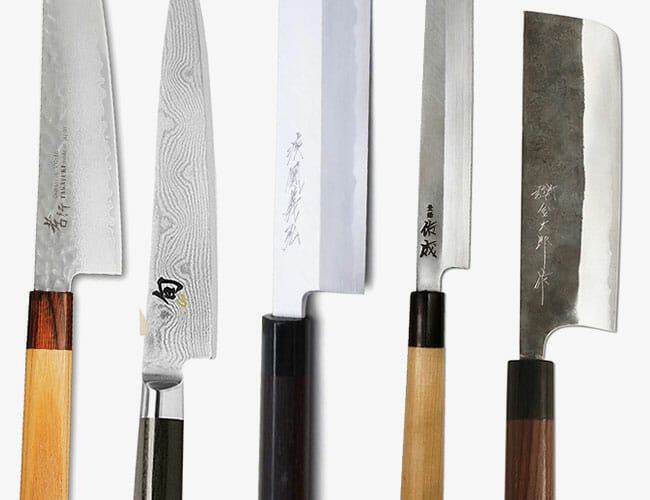There are many different types of Japanese chef knives, each with its own unique purpose. The most common type of knife is the gyuto, which is a general-purpose knife that can be used for slicing, dicing, and mincing. Other popular types of knives include the santoku (a versatile all-purpose knife), the nakiri (a vegetable knife), and the usuba (a traditional Japanese vegetable knife).
There are many different types of Japanese chef knives, each with its own unique purpose. Here is a quick guide to some of the most popular types:
1. Santoku Knife – The Santoku knife is a versatile all-purpose knife that can be used for slicing, dicing and mincing.
It has a relatively short blade which makes it easy to control.
2. Nakiri Knife – The Nakiri knife is designed specifically for vegetable preparation. It has a wide, thin blade which makes it perfect for slicing and chopping vegetables.
3. Gyuto Knife – The Gyuto knife is a general-purpose chef’s knife that can be used for everything from slicing meat to chopping vegetables. It has a longer blade than the Santoku or Nakiri knives, making it ideal for larger tasks such as jointing chicken or carving roast beef.
4. Sujihiki Knife – The Sujihiki knife is designed specifically for slicing meat and fish.
It has an extremely sharp, long blade which makes it perfect for thinly slicing steak or smoked salmon.

Credit: www.gearpatrol.com
What are Japanese Chefs Knives Called?
There are a few different types of Japanese knives, but the most common one is called a gyuto. It’s similar to a Western chef’s knife, and can be used for a variety of tasks like chopping, slicing, and dicing. Other popular Japanese knives include the santoku (a all-purpose knife), the nakiri (a vegetable knife), and the usuba (a vegetable knife with a thinner blade).
How Do You Identify Japanese Kitchen Knives?
When it comes to Japanese kitchen knives, there are a few things you can look for that will help you identify them. First, most Japanese knives will have a much thinner blade than their Western counterparts. This is because the traditional Japanese diet consists of mostly fish and vegetables, which require a thinner blade to make clean cuts.
Additionally, the edge of a Japanese knife is usually much sharper than a Western knife since they are designed for precision cutting. Finally, many Japanese knives will have a distinctive “waist” near the handle that makes them easier to grip and control.
What is the Difference between a Gyuto And Santoku?
When it comes to Japanese kitchen knives, there are many different types available to choose from. Two of the most popular and commonly used options are the gyuto and santoku knives. So, what’s the difference between these two types of knives?
Gyuto Knives
Gyuto knives are typically considered to be all-purpose kitchen knives. They can be used for a variety of tasks, including chopping, slicing, and dicing.
Gyuto knives usually have a curved blade, which makes them ideal for rocking motions when cutting. This type of knife is also typically longer than a santoku knife, making it better suited for larger cutting tasks.
Santoku Knives
Santoku knives are also versatile all-purpose kitchen knives. However, they tend to be shorter than gyuto knives and have a straighter edge. This design makes them better suited for push cuts (rather than rock cuts).
Santoku knives often have a granton edge, which helps to prevent food from sticking to the blade.
Do Chefs Use Japanese Knives?
Yes, chefs do use Japanese knives. In fact, many chefs prefer them to Western-style knives because of their superior construction and sharpness. Japanese knives are made with a harder steel which holds its edge better, and they are also thinner and lighter than Western knives, making them easier to maneuver.
How To Use Every Japanese Knife | Method Mastery | Epicurious
Gyuto Knife
Gyuto knives are a type of Japanese chef’s knife that is used for a variety of tasks, including slicing, dicing, and mincing. The word “gyuto” means “cow sword,” and these knives are named after the fact that they were traditionally used to butcher cattle. Gyuto knives have a sharp point and a curved edge that makes them ideal for slicing through tough meats.
These days, gyuto knives are also commonly used in sushi restaurants to prepare fish.
Gyuto knives are made with high-carbon steel, which gives them their signature sharpness. The blades are often heat-treated to further increase their durability and strength.
Most gyuto knives have a double-beveled edge, which means that they can be used by both left-handed and right-handed people.
When shopping for a gyuto knife, it is important to find one that fits your hand comfortably. The blade should be long enough to allow you to slice through large pieces of meat or fish without difficulty.
It is also important to choose a knife with a comfortable grip so that you can use it for extended periods of time without experiencing fatigue.
If you are looking for a versatile and durable kitchen knife, then a gyuto knife is an excellent option. With its sharp blade and comfortable grip, it will make quick work of any chopping task you throw its way.
Kiritsuke Knife
A Kiritsuke knife is a traditional Japanese blade that has many uses in the kitchen. It can be used for chopping vegetables, slicing meat, and even filleting fish. The Kiritsuke is a versatile tool that any chef would be happy to have in their arsenal.
The Kiritsuke is also known as the “Master Chef’s Knife” because of its versatility and ability to tackle any task in the kitchen. If you are looking for a knife that can do it all, then the Kiritsuke is the blade for you.
Japanese Nakiri Knife
A Nakiri knife is a traditional Japanese vegetable knife. It is characterized by its rectangular blade, which is ideal for slicing, dicing and chopping vegetables. The word “nakiri” actually means “leaf cutter” in Japanese, referring to the fact that this type of knife is perfect for cutting through leafy greens.
Nakiri knives are typically made with carbon steel or stainless steel blades. Carbon steel blades are known for their sharpness, but they can be more difficult to care for than stainless steel blades. Stainless steel blades don’t require as much maintenance and are less likely to rust, making them a popular choice among home cooks.
When shopping for a nakiri knife, it’s important to find one that fits comfortably in your hand. The blade should be about 6 inches long and 1-2 inches wide. The handle should be made from wood or plastic and should fit snugly in your palm.
If you do a lot of cooking at home, investing in a good quality nakiri knife will make your life much easier. With its sharp blade and comfortable handle, it’s the perfect tool for prepping all kinds of veggies.
Best Beginner Japanese Chef Knife
If you’re looking for the best beginner Japanese chef knife, look no further than the Shun Classic 8-Inch Chef’s Knife. This versatile knife is perfect for a wide variety of tasks, from slicing and dicing vegetables to chopping herbs and mincing garlic. The Shun Classic features a durable VG-10 stainless steel blade that holds its edge well and is easy to sharpen.
The traditional Japanese handle is made from PakkaWood, a durable synthetic material that resists moisture and provides a comfortable grip.
The Shun Classic 8-Inch Chef’s Knife is an excellent choice for both novice cooks and experienced chefs alike. It’s reasonably priced, perfectly balanced, and incredibly sharp.
If you’re looking for a top-quality chef knife that will last a lifetime, the Shun Classic is the one for you.
Japanese All Purpose Knife
A Japanese all purpose knife is a versatile kitchen tool that can be used for a variety of tasks, from slicing and dicing vegetables to mincing meat. These knives are made with a high-carbon steel blade that is sharpened to a 16 degree angle, which provides a razor-like edge that is ideal for precision cutting. In addition to their sharpness, Japanese all purpose knives are also known for their durability and easy maintenance – making them an excellent choice for both professional and home cooks.
Single Bevel Japanese Knife Types
There are many different types of single bevel Japanese knives, each designed for a specific purpose. The most common type is the gyuto, which is a general-purpose chef’s knife. Other popular types include the santoku, a versatile all-purpose knife; the nakiri, ideal for chopping vegetables; and the usuba, perfect for slicing and julienning.
No matter what type of single bevel Japanese knife you choose, you can be sure it will provide superior performance in the kitchen. These knives are made with high-quality carbon steel that holds an incredibly sharp edge. They are also extremely well balanced, making them comfortable and easy to use.
If you’re looking for a top-quality knife that will make meal prep easier than ever before, consider investing in a single bevel Japanese knife!
Small Japanese Knife Name
A small Japanese knife is a knife that is used for various delicate tasks such as slicing fruits and vegetables, filleting fish, and cutting meat. The most common type of small Japanese knife is the Santoku knife which means “three virtues” or “three uses” in Japanese. The three uses are slicing, dicing, and mincing.
Santoku knives typically range in blade length from 13 to 18 cm (5 to 7 inches).
Other types of small Japanese knives include the Petty knife which is similar to a paring knife and ranges in blade length from 8 to 12 cm (3 to 5 inches), the Nakiri knife which is a vegetable knife with a rectangular blade that ranges in blade length from 15 to 20 cm (6 to 8 inches), and the Sujihiki knife which is a long and slender slicingknife that ranges in blade length from 21 cm (8 inches) up to 30 cm (12 inches).
Small Japanese knives are made with either carbon steel or stainless steel blades.
Carbon steel blades are considered superior because they hold an edge longer than stainless steel blades; however, they require more maintenance because they can rust if not properly cared for. Stainless steel blades do not rust as easily as carbon steel but they do not hold an edge as well.
The handles of small Japanese knives are usually made out of wood or plastic.
Wood handles provide good grip but can crack over time whereas plastic handles do not provide as good of a grip but are more durable.
No matter what type of small Japanese knife you choose, it is important to care for it properly by hand washing it after each use and drying it immediately. It is also important to store your knives safely by using a sheath or storing them in a block so that the blades do not become damaged.
Conclusion
There are many different types of Japanese chef knives, each with its own unique purpose. The most common type is the Santoku knife, which is perfect for chopping vegetables and fruits. For slicing meat, the Yanagiba knife is the best choice.
If you need a versatile all-purpose knife, then the Gyuto knife is ideal. Finally, the Usuba knife is specifically designed for cutting vegetables into thin slices.
